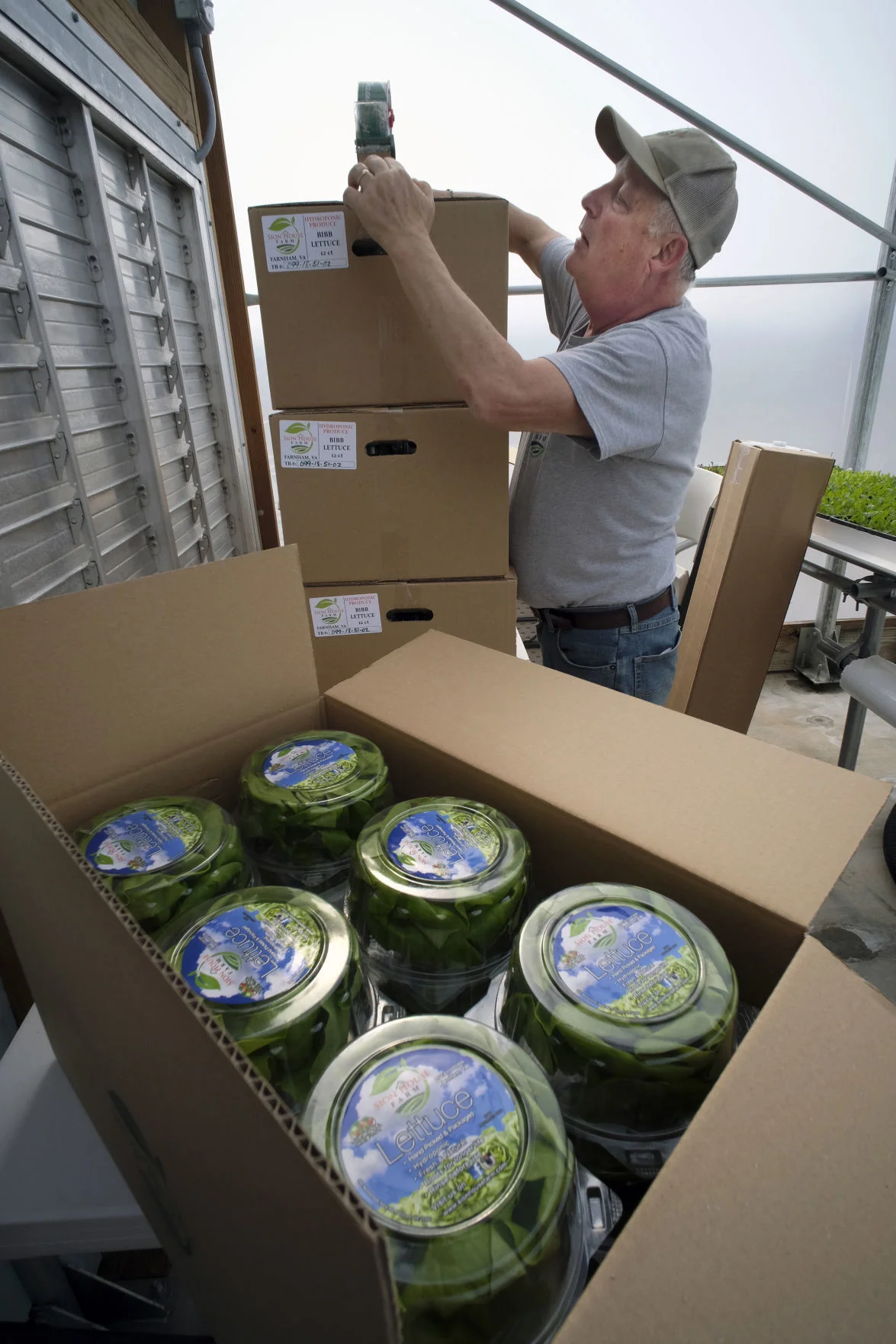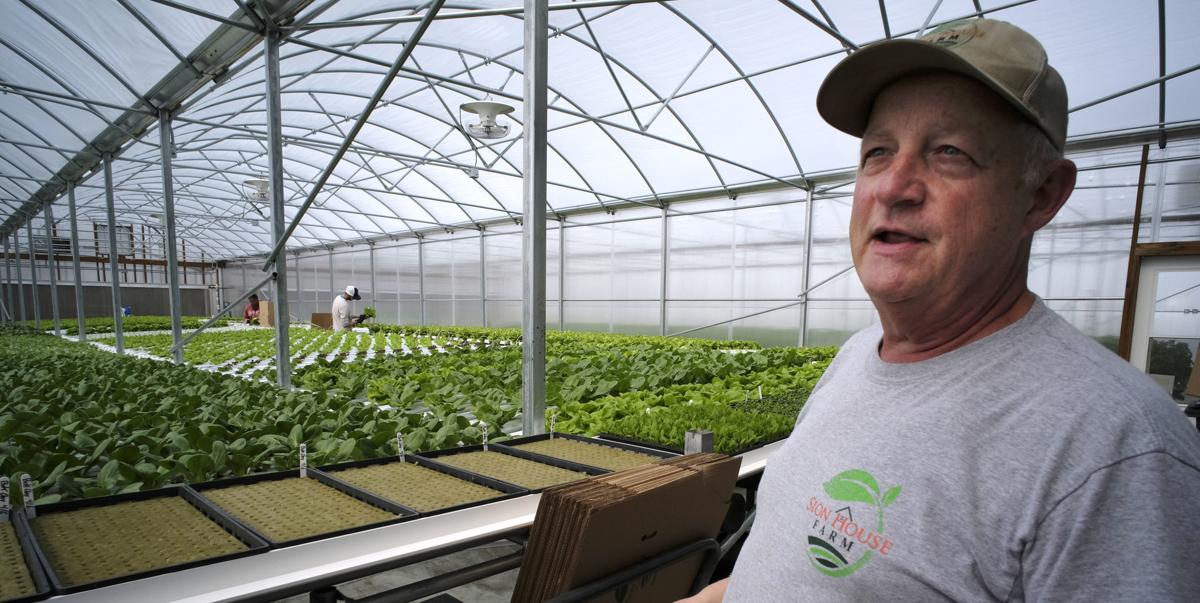Family Harvest: Hydroponic Farming Provides A New Job And A New Life On The Northern Neck
Family Harvest: Hydroponic Farming Provides A New Job And A New Life On The Northern Neck
April 16, 2018
Farnham, Virginia
As snow fell on the fields of the Northern Neck last month, Justin McKenney was in his tomato greenhouse tending to his plants with his young assistants: daughters Josslyn, 5, and Joely, 2.
Last week, he was back in the greenhouse, and the plants were about 4 feet tall with plump, green tomatoes forming on the vines. He expects to pick the first ripe tomatoes by the end of April. He will harvest until December, with each of his 1,050 plants — growing to about 40 feet in length by then — producing upwards of 50 pounds of tomatoes for the year.
Hydroponic farming has its advantages.
Before they launched Sion House Farm in 2015, McKenney and his father, Jack Mc- Kenney, had no connection to farming, except for cousins who farmed land along the Rappahannock River that has been in the family for more than a century. Justin McKenney, 32, worked for an oil-field services company in Pennsylvania; Jack McKenney, 64, had retired from a career in banking.
“I’d never grown anything,” said Justin. “I don’t think I’d even grown grass seed.”
But they were looking for a joint business venture so Justin could start a new career, his old job having worn him down with the night shifts and long hours that kept him away from his wife and young daughters. They also wanted to do something that might bring them together on the Northern Neck, where neither had lived full-time but both had spent summers and many weekends during their youth visiting grandparents and cousins.
Scouting around for an opportunity, Jack came upon hydroponic farming — essentially growing plants without benefit of soil — and looked into it. The men were further intrigued after attending a two-day orientation in Ohio held by a company that manufactures hydroponic supplies. After a particularly unhappy night on the job in Pennsylvania, Justin called his father: “I’m tired of this. Let’s do it.”
Justin and his wife, Jamie, decided to make the move, and they relocated to the Northern Neck, near the Farnham community. Justin acquired 12 acres of family land that had been in grain production and set up four greenhouses.
Justin has taught himself about hydroponic farming, becoming a voracious reader on the subject and making Google and YouTube his personal online classrooms, while his dad is generally more involved with sales and deliveries and that side of the business. Both McKenneys live nearby. Justin and Jamie’s home, just beyond the greenhouses, is in the approximate footprint of where his great-grandparents’ home stood.
Besides tomatoes, they raise bibb lettuce and bok choy year-round, selling to supermarkets (including Tom Leonard’s in Richmond), wholesalers, home-delivery services and roadside stands. They have added two greenhouses, and Justin has branched out into field-farming, where he will grow several acres of sweet potatoes, potatoes, and tomatoes this summer. For someone who had never even grown grass, Justin has embraced his new profession and lifestyle.
“Absolutely, I love it,” he said. “My days haven’t gotten any shorter. They’re just in daylight now instead of in the dark.”
***
Jack McKenney’s great-grandfather, Carter Mothers- head, acquired a stretch of land along the Rappahannock, between Sharps and Morattico, about 1906. Four of his sons farmed the land and made their homes along what is now known as Mothershead Neck Road, where Sion House Farm occupies about a dozen acres. (The farm takes its name from a former plantation house on the property, thought to be the childhood home of Cyrus Griffin, who served as the last president of the Continental Congress prior to ratification of the U.S. Constitution.)
“This was called ‘coming to the country,’ ” said Jack, who grew up outside Philadelphia. “I was the oldest grandchild, and I got to hang around with my grandfather. I felt pretty lucky.”
In high school, Jack’s family moved first to Tampa, Fla., and then to Richmond, where he was in the first class to graduate from what was then the “new” Hermitage High in the spring of 1972. After attending the University of Virginia, he went into banking, working mostly in Northern Virginia, where Justin and his two siblings grew up.
Justin also grew up with a long-distance affection for the Northern Neck and liked the notion of making his home there, though job prospects seemed limited until he and his father struck upon the idea of hydroponic farming.
Hydroponic farming is not an inexpensive venture — with its infrastructure and internal systems controlled by computers, propane to warm the greenhouses in winter, electricity to operate pumps and fans around the clock, and the labor necessary for frequent planting and transferring (in the case of lettuce and bok choy), and pruning and trellising (in the case of tomatoes) and regular harvesting of everything. But it also doesn’t require the capital investment of expensive machinery for conventional farming and is not at the mercy of variables such as weather.
High wind or hail storms can destroy field crops in a matter of seconds, and heat and drought are always serious possibilities. Not so in greenhouses. A run of cloudy days can slow the growth of plants coming up indoors, and extreme cold can raise heating costs, but an indoor crop is generally safe from outside disasters. Pests and disease also can be managed somewhat more easily in a greenhouse’s climate-controlled environment, though plants grown indoors are certainly not immune.
Production in a hydroponic operation also is more predictable, Justin said, and there is little waste: he sells almost everything he grows. What he doesn’t sell he gives to a local food bank, and if he has some particularly unsightly produce that has hung around the greenhouse a little too long, he’ll drop it off at a buddy’s pigpen.
And his operation becomes particularly lucrative when he can attract a premium price for his fresh produce when other local growers don’t have it to sell — vine-ripened tomatoes in May or November and lettuce in the heat of the summer.
“I’m definitely sold on [hydroponic farming],” he said. “We can make the plants do what we want them to do.”
The lettuce and bok choy grow in long trays, roots dangling in a closed-circuit stream of ever-moving water that is constantly refreshed and replenished with nutrients. In the case of each, it’s about 48-62 days from seed to harvest, depending on the time of year and the availability of daylight, Justin said. The tomatoes grow in Perlite, a lightweight soil substitute, and are fed by drip irrigation every half-hour. Hives of bumblebees pollinate the tomatoes.
How much land would be required to produce the same amount of food?
“I don’t know the answer to that,” Justin said, “but I know it’s way higher than what we are doing here.”
Last year, he said, Sion produced 42,000 pounds of tomatoes in a 4,200-square-foot greenhouse, the equivalent of about one-tenth of an acre.
Jack McKenney said the future of hydroponic farming is promising because “you’re able to produce so much more in smaller acreage, you’re able to go year-round, and you don’t use as much water.”
Elaine Lidholm, director of communications for the Virginia Department of Agriculture and Consumer Services, agreed.
“It is safe to say that hydroponics is a very small part of the overall industry of agriculture, but it is growing, and I believe it will continue to grow,” she said in an email.
“This is just my opinion, but I wouldn’t be surprised if we saw a real burst of new companies in the very near future. I think it has advantages for new farmers or urban farmers, although it can occur on farms, too. It is a good fit for urban agriculture, and the world is becoming more urbanized every year. I don’t think it’s going to feed the world by itself, but it can help, and we are going to have to explore every avenue for food production in order to feed the burgeoning world population.”
(804) 649-6639



















